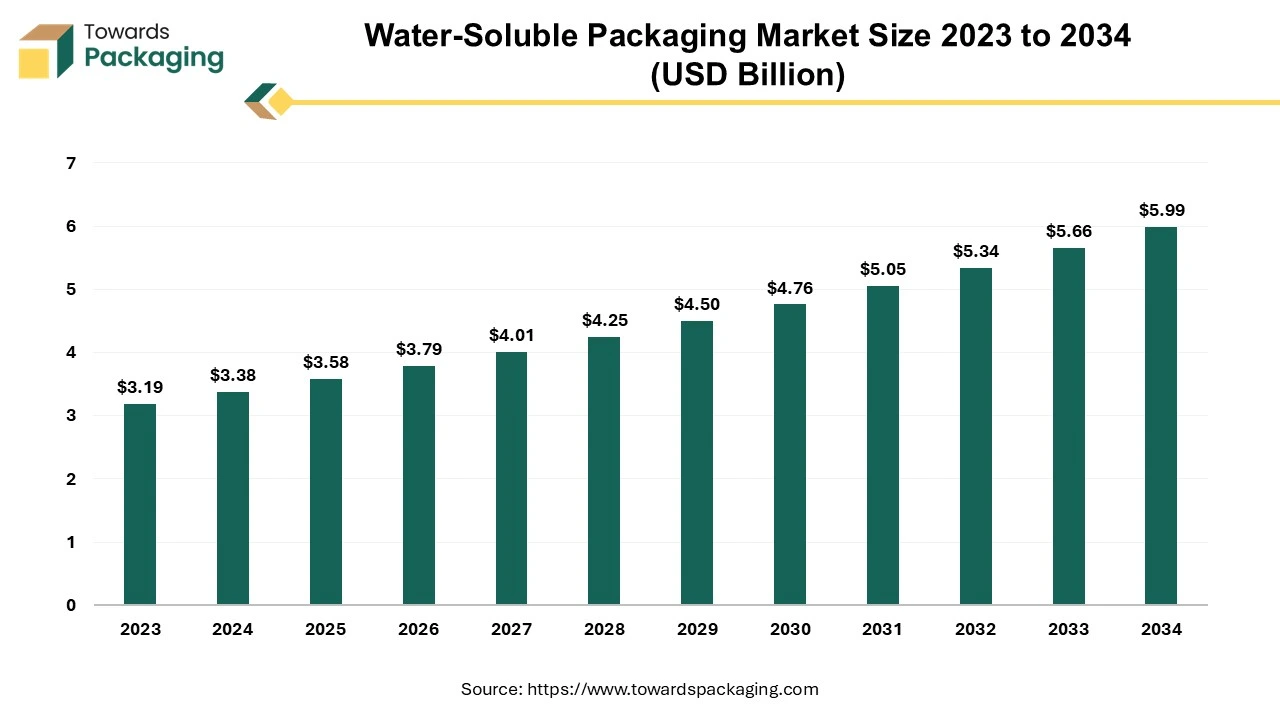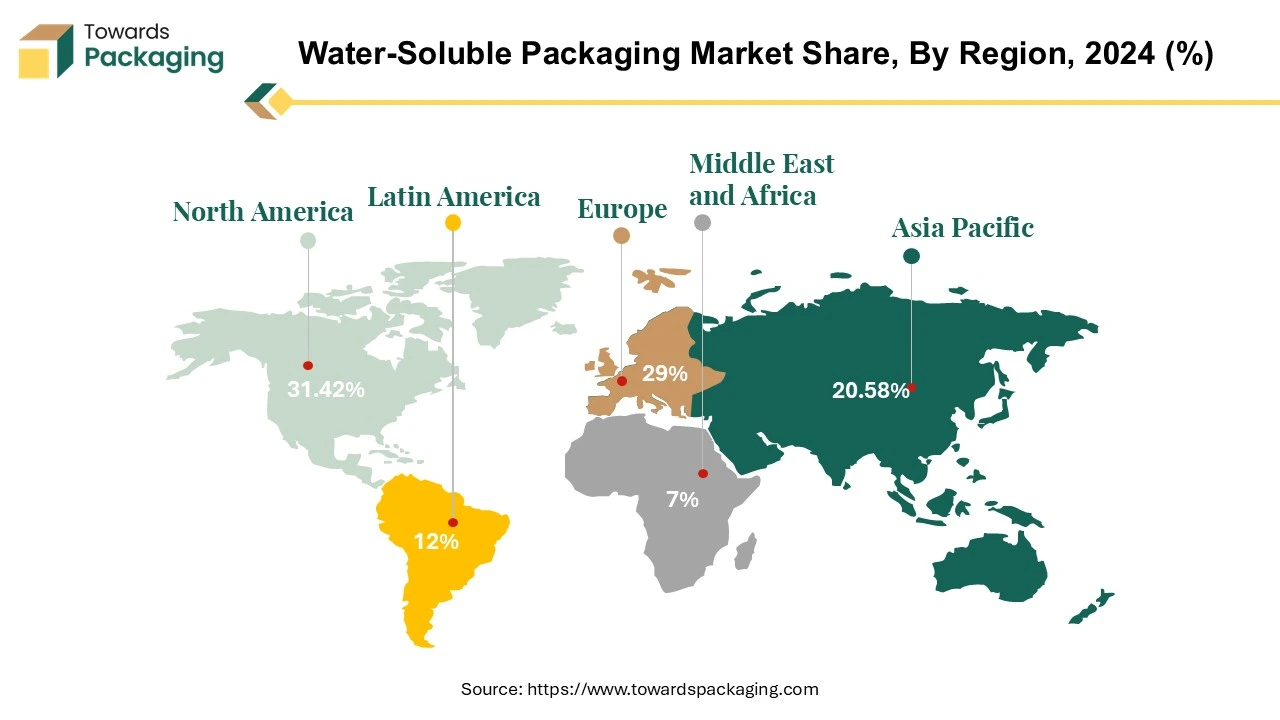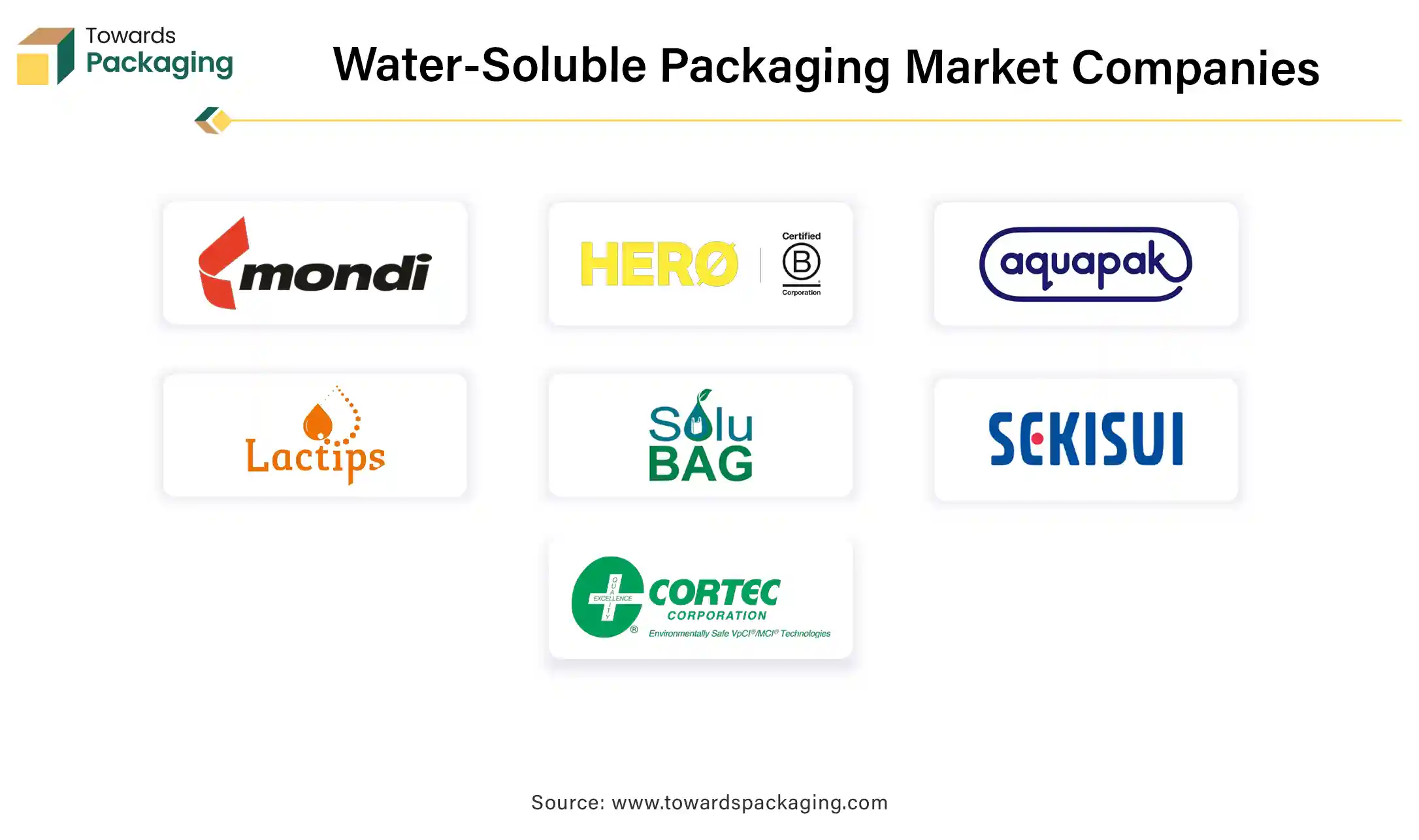March 2025
.webp)
Principal Consultant

Reviewed By
The water-soluble packaging market is expected to grow from USD 3.58 billion in 2025 to USD 5.99 billion by 2034, with a CAGR of 5.9% throughout the forecast period from 2025 to 2034.

Water-soluble packaging is a packaging material that can disintegrate or dissolve in water; it is also known as biodegradable packaging. These materials are designed to break down when they encounter water, leaving little to no residue behind. This type of packaging is often used for various purposes, including environmental sustainability and convenience.
Water-soluble packaging has emerged as a revolutionary solution poised to significantly reduce plastic waste and pollution. These films, crafted from biodegradable polymers or other natural materials, are ingeniously designed to break down harmlessly when exposed to water or moisture, presenting a powerful antidote to the environmental challenges posed by traditional packaging materials.
By 2025, the total amount of solid trash is anticipated to reach 2.2 billion tonnes yearly. Utilizing packaging materials that are neither renewable nor biodegradable might harm the environment. Additionally, as consumers' knowledge of environmental and health concerns has grown over the past few decades, there has been a rapid demand for safe, healthful foods that use as little chemical, synthetic, or plastic-based input as possible.
The hallmark of water-soluble packaging lies in its remarkable ability to dissolve or disintegrate when immersed in water. It offers many applications that promise to reshape how products are packaged, used, and disposed of. One notable application is in single-use items, exemplified by detergent packets that effortlessly dissolve in the washing machine during use. This simplifies the laundry process and eliminates the need to dispose of traditional plastic packaging, contributing to a cleaner environment.
The transformative potential of water-soluble packaging extends beyond the detergent. In agriculture, controlled-release fertilizers encased in water-soluble films represent a novel approach. The packaging dissolves upon application, seamlessly integrating with the soil and eliminating the burden of unwrapping and disposing of conventional fertilizer packaging. This not only streamlines agricultural practices but also aligns with sustainable farming principles.
Moreover, the food industry benefits significantly from this innovative packaging solution. Water-soluble packaging for food products can eliminate the need for traditional wrappers. Consumers can place the water-soluble packaged food into hot water, dissolving the packaging and revealing the untouched product. This not only enhances the consumer experience but also contributes to a reduction in overall packaging waste.
As industries increasingly prioritize sustainability, water-soluble packaging emerges as a versatile ally in pursuing eco-friendly alternatives. Its adaptability and potential to revolutionize packaging practices position it as a catalyst for change. By addressing the environmental impact of packaging materials, water-soluble packaging represents a beacon of hope for a more sustainable and responsible future, where convenience and ecological consciousness coexist harmoniously in the products.
| Trends | |
| Increased Use of Biodegradable Materials | The water-soluble packaging market is experiencing a notable transition towards employing biodegradable and compostable materials, responding to heightened environmental consciousness. Manufacturers actively explore innovative materials like polysaccharide-protein-based films, align with eco-friendly principles, and meet evolving consumer preferences for sustainable packaging solutions. |
| Focus on Agricultural Solutions | Water-soluble packaging is gaining prominence in agriculture, notably for fertilizers and agrochemicals. This packaging dissolves upon application, mitigating the environmental footprint linked to conventional packaging. Adopting such innovative solutions reflects a commitment to sustainable practices within the agricultural sector. |
| Expanding Applications in Healthcare | Water-soluble packaging is increasingly used in the healthcare sector, specifically for pharmaceuticals and medical products. This trend is propelled by the imperative for convenient and secure packaging disposal within healthcare settings. Adopting such packaging solutions underscores a commitment to safety, hygiene, and environmentally responsible practices in the healthcare industry. |
| Technological Advancement in Film Production | Continuous research and development initiatives drive notable technological progress in water-soluble film production. These advancements encompass film strength, barrier properties, and dissolution characteristics. The resulting packaging is becoming more resilient and versatile, catering to diverse sectors, including healthcare, chemicals, food, and beverage. This evolution underscores a commitment to innovation and heightened performance standards. |

Due to environmental concerns, numerous cities in the US, alongside states like California and New York, have implemented bans on single-use plastics. This shift towards sustainability has catalyzed the growth of the biodegradable plastics market, with North America as the leading region in the water-soluble packaging market.
The establishment of advanced standards and certification systems underscores the maturity of the water-soluble plastics market in North America. Notable benchmarks include the Euthe American Society for Testing and Materials (ASTM) standards in the US and ISO standards sanctioned by the International Organization for Standardization.
These regions have witnessed the development of well-defined biodegradable plastics markets. Implementing bans on single-use plastics in various cities and states has propelled the adoption of eco-friendly alternatives. Stringent regulations and consumer awareness have further driven the demand for biodegradable plastics, leading to the establishment of comprehensive standards and certification frameworks.
The biodegradable plastics industry in North America benefits from advanced standards and certification systems. These frameworks are pivotal in ensuring product quality, performance, and environmental impact. Noteworthy standards include the ASTM standards in the US and ISO standards, providing a comprehensive foundation for businesses to align with sustainability objectives and meet regulatory requirements.
As the global demand for water-soluble plastics intensifies, market players are anticipated to navigate evolving standards and explore innovative solutions. The trajectory of the biodegradable plastics market hinges on continuous collaboration, technological advancements, and adherence to international standards. Businesses in this space are poised to contribute significantly to the global shift towards sustainable and environmentally conscious practices.
Europe is positioned as a burgeoning leader in the biodegradable plastics market, yet the transformative momentum is notably expanding into Asia, with China and India at its forefront. This shift is propelled by stringent plastic restriction policies, making Asia, especially China and India, pivotal hubs for the surge in demand for biodegradable plastics. The growth is fundamentally linked to robust regulations curbing plastic usage and an intensified emphasis on sustainable practices in response to environmental concerns. As these countries confront the adverse effects of plastic, the biodegradable plastics market is witnessing substantial momentum, opening noteworthy avenues for manufacturers and investors keen on tapping into the evolving landscape of sustainable solutions in the plastics industry.
Water-soluble packaging is emerging as a transformative solution with widespread applications in food, healthcare, agriculture, and consumer products. With a surge in consumer awareness regarding environmental concerns and an increasing focus on corporate social responsibility, industries actively seek eco-friendly alternatives. Water-soluble packaging addresses these concerns by offering a sustainable option that aligns with evolving consumer values.
Regulations addressing plastic waste are becoming more stringent, prompting industries to reevaluate their packaging strategies. Water-soluble packaging provides an avenue for compliance with these regulations while contributing to reducing plastic waste. It positions itself as a proactive response to the evolving regulatory landscape, ensuring businesses stay ahead of environmental mandates.
The growth of water-soluble packaging is intricately linked to using biodegradable and compostable materials. As customer demand for eco-friendly packaging solutions escalates, businesses are expected to pivot towards materials that align with these preferences. Incorporating biodegradable polymers and compostable substances in water-soluble packaging addresses environmental concerns and underscores a commitment to sustainable practices.
The adoption of water-soluble packaging is forecasted to grow substantially as businesses strategically position themselves in response to market trends. By integrating this innovative packaging solution, industries can meet consumer expectations and stay ahead in a competitive landscape that increasingly values sustainability.
Water-soluble packaging emerges as a pivotal tool for businesses navigating the intersection of consumer demand, regulatory compliance, and environmental responsibility. As industries pivot towards sustainable practices, water-soluble packaging is a versatile and pragmatic solution, offering a promising pathway to a more eco-conscious future.
In water-soluble packaging, the polymer segment is a pivotal component, harnessing the transformative potential of polymers that dissolve in water. This innovative approach provides a sustainable alternative to conventional packaging materials and propels the expansion of the water-soluble market by virtue of its versatile applications.
Water-soluble polymers are central in developing packaging materials that dissolve upon contact with water. Among the noteworthy polymers in this domain are Polyvinyl Alcohol (PVA), Polyethylene Oxide (PEO), and starch-based polymers. These polymers exhibit unique characteristics that make them well-suited for various applications, contributing to the burgeoning popularity of water-soluble packaging.
PVA is a widely used water-soluble polymer known for its excellent film-forming properties and biodegradability. Derived from petroleum or natural gas, PVA dissolves rapidly in water, leaving no harmful residues. This polymer finds application in diverse sectors, including detergent packaging, where PVA-based films encapsulate single-use detergent pods, facilitating convenient and eco-friendly use.
PEO is another notable water-soluble polymer valued for its water-solubility and biocompatibility. With a range of molecular weights, PEO is adaptable to different applications. In the healthcare sector, PEO-based films are employed for pharmaceutical packaging, ensuring convenient and safe disposal. PEO's versatility extends to various industries, making it valuable in formulating water-soluble packaging solutions.
Starch-based polymers represent a natural and renewable source for water-soluble packaging. Typically derived from corn, potatoes, or other plant sources, these polymers offer a sustainable alternative. Starch-based films exhibit desirable properties such as flexibility and biodegradability, making them suitable for applications in agriculture, where the packaging of fertilizers dissolves upon application, aligning with environmentally conscious farming practices.
Using water-soluble polymers addresses the pressing need for sustainable packaging solutions in a world increasingly focused on environmental stewardship. These polymers offer an effective means of packaging and contribute to reducing the ecological impact associated with traditional materials. As consumers and businesses prioritize sustainability, water-soluble packaging emerges as a strategic choice underpinned by the eco-friendly attributes of its polymer components.
The water-soluble packaging market is experiencing substantial growth, driven by the widespread adoption of polymers that dissolve in water. Industries ranging from healthcare to agriculture are embracing these innovations. In healthcare, the convenience and safety of disposal afforded by water-soluble packaging contribute to its increasing use in pharmaceutical packaging. Additionally, applications extend to the agricultural sector, where water-soluble films encapsulate fertilizers, ensuring easy and environmentally friendly distribution.
The evolution of water-soluble polymers is poised to continue with ongoing research and development efforts. Collaboration between polymer manufacturers, technology innovators, and end-users is vital for pushing the boundaries of performance-enhancing film strength, dissolution rates, and overall functionality. As the market expands, industries will likely witness a proliferation of water-soluble packaging solutions tailored to specific needs and sectors.
The polymer segment of water-soluble packaging is a linchpin in the paradigm shift towards sustainable and environmentally conscious packaging. PVA, PEO, and starch-based polymers exemplify the versatility and efficacy of water-soluble polymers, contributing to the growing success of this innovative packaging solution across diverse industries. As businesses increasingly align with eco-friendly practices, the role of water-soluble polymers in shaping the future of packaging remains pivotal.
Chemicals employed in agriculture pose significant risks to the environment and human health due to their inherent toxicity. As a result, there is a growing emphasis on the materials used in agricultural packaging. Traditional agricultural packaging, typically involving glass bottles for liquid chemicals, presents several drawbacks. These include the risk of breakage leading to toxic leaks, substantial chemical waste from leftover residues, and environmental contamination when improperly discarded.
Addressing these challenges, Polyvinyl Alcohol (PVA) packaging films and bags have emerged as a transformative solution. PVA's unique physical properties and biodegradability have propelled its popularity in fertilizer and pesticide packaging. Unlike conventional materials, PVA minimizes the risk of leakage, reduces chemical waste, and provides an eco-friendly alternative, aligning with the increasing demand for sustainable agriculture practices. This shift towards PVA packaging signifies a crucial step in mitigating the long-term environmental impact of traditional agricultural packaging methods. In conventional dyeing, plastic buckets or standard plastic bags for depositing dyestuff lead to several operational challenges. The used plastic bags result in a significant accumulation of chemical waste, incurring substantial disposal costs. Moreover, the need for ample space to accommodate these plastic buckets contributes to heightened cleaning expenses. Additionally, residues in both buckets and PE bags compromise the accuracy of the requested dyestuff weight, impacting operational precision.
A strategic shift towards more efficient and sustainable dye application methods is imperative to address these issues. Embracing innovative packaging solutions can alleviate the environmental impact, streamline operational processes, reduce disposal costs, and enhance precision in the dyeing workflow. This transition aligns with contemporary business goals centred on sustainability, cost-effectiveness, and operational excellence in the textile industry.
The utilization of Polyvinyl Alcohol (PVA) film, distinguished by its water-soluble and biodegradable attributes, has gained significant traction in the packaging sector. This innovative film is extensively employed in packaging cleansers, detergents, and disinfectors. Its water-soluble nature ensures convenient and eco-friendly use, aligning with the heightened demand for sustainable packaging solutions. PVA film enhances the overall appeal of the packaged products and contributes to environmentally conscious practices in the cleaning and disinfection industry.
Water-soluble packaging is widely used in agriculture because it can increase sustainability and decrease plastic waste. The water-soluble market is characterized by intense competition among key industry players, including Mondi Group, Lithey Inc., Aquapak Polymer Ltd, Lactips, Mitsubishi Chemical Holdings, Aicello Corporation, and Sekisui Chemicals.
Market participants prioritize sustainability, innovation, regulatory compliance, and cost-effectiveness concerning competitiveness. To maintain its lead in the water-soluble packaging industry, they are broadening their products, creating new materials and technologies, and working with other businesses and organizations.

By Raw Material
By End Use
By Region
March 2025
March 2025
March 2025
March 2025